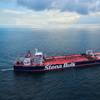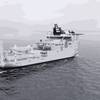The spate of recent accidents at sea involving high profile cruise ships has spurred fears among owners and operators that once again the long arm of the law will be reaching out to demand new levels of safety products, systems and procedures onboard luxury cruise liners. The cruise shipping industry, which has enjoyed unprecedented growth for much of the decade, has been beset by some unsightly accidents and mishaps that have raised the watchful eyes of legislators around the globe.
AAt a recent hearing on S. 1510, The United States Cruise Ship Tourism Development Act, Senator John McCain, Chairman of the Senate Committee on Commerce, Science and Transportation, said in his opening statement: "I believe that continued failure by the international cruise industry to abide by all U.S. and international laws and regulations for operation in and out of our ports and to meet high standards with regard to passenger safety and well-being will result in action to restrict access, not expand it. I challenge them to improve their operations and warn them that if they don't, the Congress will act." The statement is made more significant by the fact that S. 1510 is not about improving cruise ship safety, per se, rather a measure to allow more U.S. companies to reap the benefits of the cruise popularity windfall.
Weathering the Storm
Senator McCain's statement in his testimony clearly indicates that, warranted or not, safety issues aboard modern cruise ships is clawing its way toward the top of legislative agendas. Maritime safety, in general, is a very emotional topic that usually peaks immediately following accidents, i.e. Exxon Valdez. The cruise industry has unintentionally placed a full plate of fodder for legislators to chew on. A series of accidents at sea, combined with recent criminal activity surrounding sex crimes and pollution, have generated more bad publicity for the cruise market in the past few months than the past few years combined.
The latest incident involved a fire in the engine room aboard Carnival's Tropicale, an accident that left the vessel without power and on the fringe of a tropical storm. Compounding the matter, the consumer press in the U.S. has sensationalized the matter, giving extensive, disparaging coverage regarding conditions aboard the disabled vessel, which was carrying approximately 1,700 passengers and crew.
Not to isolate Carnival, but it was recently involved in another scandal regarding sexual assault.
Carnival Cruise Lines, which carry about two million vacationers a year, was accused of sexual assault 62 times in the five years up to last August. Carnival Cruise Lines gave few details of the 62 allegations investigated by company security staff other than to say each matter was referred to police if the accuser wished. At the time, Senator McCain said: "I am extremely concerned about recent reports of cruise ship crew members sexually assaulting passengers and co-workers. Cruise ship companies should do everything in their power to ensure that this criminal activity does not occur, regardless of where the ship is flagged.
"Carnival — and for that matter, the U.S. cruise market — has not been alone in it troubles, as two other prominent carriers — Norwegian Cruise Lines and Royal Caribbean — have had recent troubles as well.
Norwegian Cruise Line's 50,764-gt Norwegian Dream, carrying 2,400 passengers — was involved in a collision with the 52,090-gt, 1997-built containership Ever Decent, in the English Channel. While only three passengers on the Bahamas-registered liner were injured, the incident has raised many concerns, as, although it occurred in the middle of the night, winds were light and visibility was good, and each vessel was reportedly outfitted with working version of the latest electronics and collision avoidance systems. Both ships were badly damaged, and several large containers with a newfound home on the deck of Norwegian Dream served to punctuate the severe damage to the ship's bow and bridge.
Meanwhile, Royal Caribbean executives spent a few days at the end of the summer touring ports in Alaska to apologize in person for pollution left in the state's waters by the cruise line's ships. Royal Caribbean agreed to pay an $18 million fine to U.S. authorities for dumping oily bilge and chemical wastes at sea, as well as into U.S. ports and wild waterways. The line plead guilty to 21 felonies, including falsifying logs and lying to the U.S. Coast Guard, and admitted Royal Caribbean ships were rigged with secret bypass pipes, which were used to dump used dry-cleaning chemicals and other waste. The fine, the highest ever assessed by a cruise line for polluting U.S. waters, followed $9 million in fines Royal Caribbean agreed to pay in 1998.
The Silver Lining
Although the cruise market has endured recent rough waters, it is a solid bet that the industry will continue to design, build and deliver vessels that help meet the burgeoning demand of cruise passengers, while meeting the demands for more luxurious accommodations and diversity of activities on board. A recent delivery to forward these values was the Disney Wonder from Fincantieri, which, like its sister-ship, embodies the style and finesse of the classic liners, or as Disney bills it, the modern classic. The 83,000-ton, 964-ft. (294-m) Disney Wonder is truly an elegant ship, with pictures not quite providing it just due. Propelled by the diesel/electric combo of five 16-cylinder Sulzer engines and two 19-MW GE propulsion motors, the ship can attain a maximum speed of 24 knots.
The Disney "fleet" has positioned itself into an interesting cruise market niche, catering to adults, families and children. Being a Disney product, the focus on entertainment and education for the younger set is amply accommodated with more than 15,000 sq. ft. dedicated to children's areas, split between the Disney Oceaneer Club for 3-8 year olds; and the Disney Oceaneer Lab for 9-12 year olds.
Another recent boost for the industry involves the signing of the contract to build the 12 deck, 644 ft. (195.8 m) ResidenSea vessel, an ocean-going luxury resort designed for the rich in that the onboard rooms and suites are for sale. The vessel was conceived four years ago by Norwegian cruise magnate Knut Kloster Jr., and represents a new concept in cruising. Buyers of ResidenSea accommodations must have a net worth of at least $5 million and be of "good character." The prices of the 110 luxury apartments are in the range $2-6.84 million, plus maintenance of five to six percent of the price tag. While the contracted vessel is much smaller than the original plans (40,000 tons and $350 million v. 86,000 tons and $545 million), spirits were high as the signing of the contract with Norway's Fosen Mek. Verksteder AS was the culmination of years of work to secure financing for the high-profile ship. Fosen shipyard nudged out Germany's Howaldtswerke-Deutsche Werft for the contract reportedly because the German yard could not comply with the scheduled target date for delivery. New from Kvaerner Masa-Yards' Helsinki New Shipyard is MS Europa, built for Germany's Hapag-Lloyd. The 28,400 gt ship is built to carry only 408 passengers, making it one of the most spacious cruise ships on the market. It was designed and constructed with an "all outside concept," meaning that all passenger suites face the sea. The ship was designed by the owner in conjunction with the yard, and included the efforts of notable companies such as DeltaMarin, Yran & Storbraaten, and consulting architect Wilfried Köhnemann. The vessel is also significant because it was designed and built in just 21 months, from the signing of the contract. This feat is impressive given the long backlog of cruise ships.
Sponsored Content
Safer Starts Here: Build Ships, Protect Crews

Subscribe for
Maritime Reporter E-News
Maritime Reporter E-News is the maritime industry's largest circulation and most authoritative ENews Service, delivered to your Email five times per week











